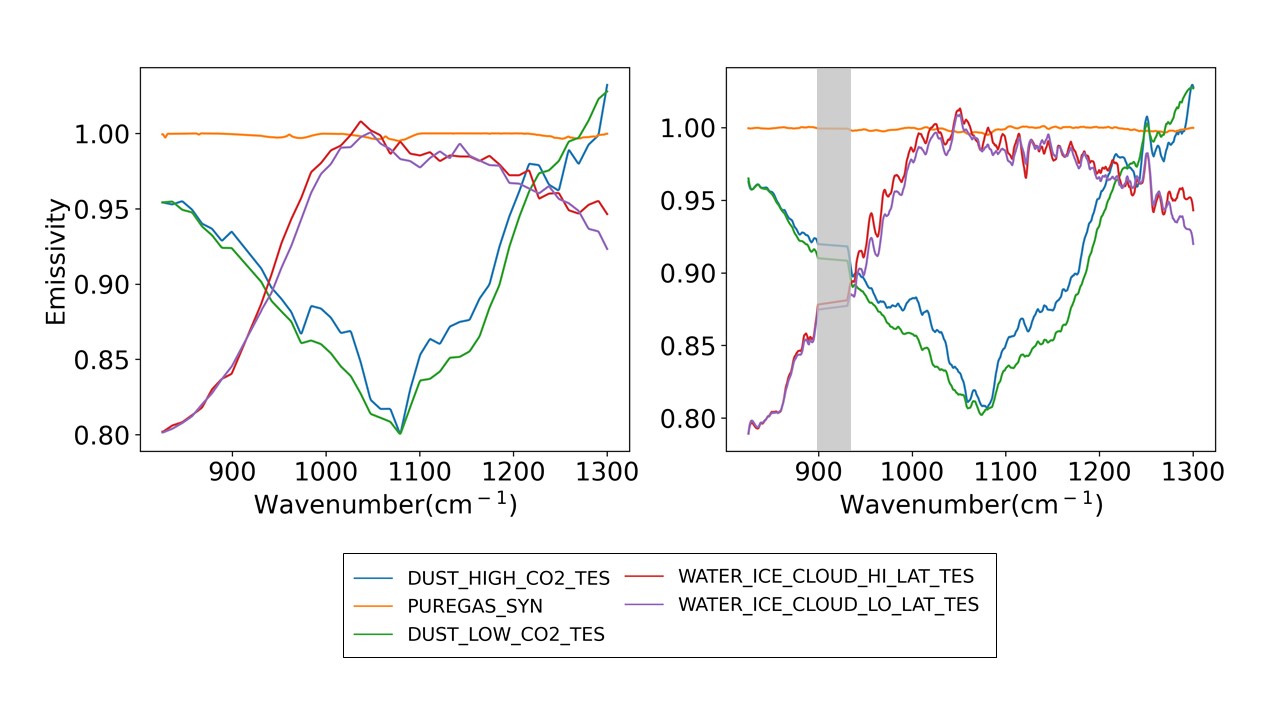Particulate atmospheric endmembers retrieval from ExoMars Thermal Infrared (TIRVIM) spectral data
- 1Institute for Planetary Research, German Aerospace Center (DLR), Rutherfordstr. 2, 12489 Berlin, Germany (giulia.alemanno@dlr.de)
- 2University of Potsdam, Institute of Geosciences, Potsdam, Germany
- 3Space Research Institute (IKI), 84/32 Profsoyuznaya, 117997, Moscow, Russia
- 4Australian National University, Canberra, ACT 2600, Australia
1. Introduction
Thermal infrared datasets from planetary bodies have the potential to provide key insights for the understanding of a planet's climate evolution and history: valuable information about composition, temperature and state of the atmosphere can be retrieved from thermal spectral data.
In this work, we present the application of a methodology based on Principal Component Analysis (PCA) and Target Transformation (TT) Factor Analysis (FA) techniques to thermal infrared data of the ExoMars2016 Trace Gas Orbiter (TGO) with the main goal to retrieve the different particulate atmospheric contributions present in the spectra and separate them from the surface contributions.
2. Instrument and dataset
TGO has a suite of spectroscopic instruments for the investigation of the Red Planet in the infrared spectral range known as Atmospheric Chemistry Suite (ACS) [1] consisting of three spectrometers observing Mars in solar occultation, nadir and limb geometry in the Near-InfraRed (NIR), Mid-InfraRed (MIR) and Thermal InfraRed (TIR) spectral channels. Among them, the ACS thermal-infrared channel (TIRVIM) covers the spectral range between 1.7-17 μm with apodized resolution varying from 0.2 to 1.3 cm−1 [1]. TIRVIM has similar capabilities to IRIS (Mariner 9), TES, and PFS in several aspects, but has some advantages: - higher spectral resolution; - better noise equivalent radiance (from 0.08 mW/m2/sr-1/cm-1); - dense spatial coverage (TGO has a circular orbit of 400 km) [1].
Martian TIRVIM spectra acquired along the orbits that cross Elysium Planitia, landing site of the NASA’s Insight (Interior exploration using Seismic Investigations, Geodesy and Heat Transport) lander, were here analyzed. The selected data orbits span from Ls=150°C to Ls=210°C, covering part of the Martian summer and of the Martian autumn going through the autumn equinox in the northern hemisphere of the planet. Corresponding Local Times cover Martian days and nights.
3. Methodology
To analyze the ExoMars TIRVIM data and retrieve and characterize the number of varying atmospheric components present in these data and their spectral shape, a methodology was applied based on a combination of PCA and TT – FA techniques [2, 3]. These techniques are demonstrated to be able to extract the composition of laboratory samples [4, 5]; to extract the principal varying components from a big spectral dataset in the thermal infrared [3], and then to identify them as components of the atmosphere and separate their contribution from surface emission [6]. This methodology, previously successfully adopted for the analysis of TES and PFS data [2, 7], was, here, applied for the first time to the analysis of the new and at higher spectral resolution TIRVIM dataset. Considering that the PCA works best when the different components have significant variation in the data, we selected data where these variations are more likely to occur: the analyzed data cover diurnal as well as seasonal variations.
A list of PFS and TES atmospheric end-members extracted from [3] and [2] were used as initial guess for the TT, to interpret the abstract eigenvectors retrieved from the PCA and attribute them a physically coherent meaning.
4. Results and future developments
Spectral shapes of atmospheric dust and water ice aerosols were recovered from the analyzed TIRVIM data. Comparisons with results previously obtained on PFS and TES data (Figure 1) validate the methodology used and show that it is capable of determining the number of independently variable components and recovering the spectral endmembers present in the TIRVIM data.

Figure 1. Comparison between the general TES/PFS extracted endmembers [2, 3] (upper panel) and the endmembers extracted from the TIRVIM data in this work (bottom panel). Grey area: wavelength cut due to high instrumental noise.
Deconvolution of the original spectra using the recovered spectral end-members allowed us to obtain the concentration coefficients of the dust and water ice end-members and retrieved abundances maps. The results obtained are promising in terms of identification and separation of the atmospheric components and have strong impact on the identification of surface contributions in the spectra. We are further investigating this point with the main goal of showing the potential of this method to extract valuable information from TIRVIM data not only on the atmosphere, but also on the surface of the Red Planet. Derived surface emissivity products are being analyzed by linear deconvolution analysis with the laboratory spectral database of Martian analogues measured at the Planetary Spectroscopy Laboratory (PSL) of DLR, in Berlin [5].
Acknowledgments
ExoMars is a space mission of ESA and Roscosmos. The ACS experiment is led by IKI, the Space Research Institute in Moscow, assisted by LATMOS in France. The science operations of ACS are funded by Roscosmos and ESA.
References
[1] Korablev et al. (2018) Space Science Review, 214:7. [2] D’Amore M. et al. (2013) Icarus, 226, 1294-1303. [3] Bandfield J.L., Christensen P.R., Smith M.D. (2000) JGR, 105 (E4), 9573-9587. [4] Smith, M.O., Adams, J.B., Johnson, P.E. (1985) JGR, 90, 797-804. [5] Alemanno G., Maturilli A., D’Amore M., Helbert J. (2021) Icarus, 368. [6] Smith M. D., Bandfield J. L. and Christensen P.R. (2000) JGR, 85 (E4), 9589-9607. [7] Maturilli, A., Helbert, J., D’Amore, M. (2009) EPSC2009, Abstract #EPSC2009-106.
How to cite: Alemanno, G., D'Amore, M., Maturilli, A., Helbert, J., Arnold, G., Korablev, O., Ignatiev, N., Grigoriev, A., Shakun, A., and Trokhimovskiy, A.: Particulate atmospheric endmembers retrieval from ExoMars Thermal Infrared (TIRVIM) spectral data, Europlanet Science Congress 2022, Granada, Spain, 18–23 Sep 2022, EPSC2022-862, https://doi.org/10.5194/epsc2022-862, 2022.

